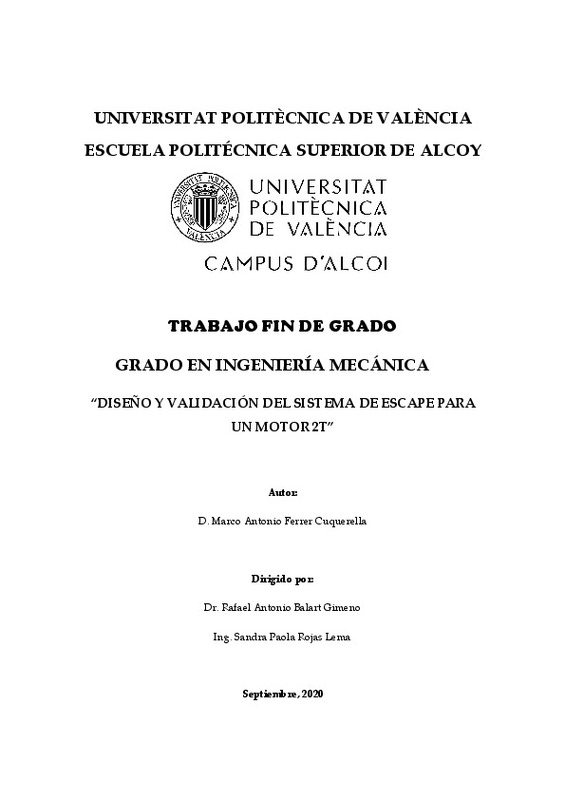|
Resumen:
|
[ES] El siguiente Trabajo Final de Grado se va a centrar en el diseño del sistema de escape de un motor de combustión interna alternativo de dos tiempos, siguiendo en todo momento las indicaciones de la normativa vigente. ...[+]
[ES] El siguiente Trabajo Final de Grado se va a centrar en el diseño del sistema de escape de un motor de combustión interna alternativo de dos tiempos, siguiendo en todo momento las indicaciones de la normativa vigente. En él se va a estudiar un motor dos tiempos monocilíndrico de aspiración natural y de una cilindrada baja, para una motocicleta.
El proceso de renovación de la carga de estos motores es debido a las diferencias de presiones entre admisión y escape, es decir, durante el barrido, y es muy frecuente que se produzca cortocircuito durante este proceso. Una de las problemáticas de estos motores es la perdida de combustible durante la etapa de barrido del ciclo de trabajo, lo que provoca un peor rendimiento, un motor menos eficiente y con mayor producción de gases contaminantes.
Este estudio pretende realizar un correcto diagrama de distribución en el que se buscarán los ángulos óptimos de avance y retraso de apertura y cierre de las válvulas, o en este caso de las lumbreras tanto de admisión o transferencia como de escape, por lo que se va a centrar en el rediseño del sistema de escape donde se analizará el fenómeno de la resonancia de las ondas a través de él para maximizar el rendimiento del motor, siendo que se permitirá una fácil evacuación de los gases de escape mediante la entrada de mezcla fresca y por el contrario se dificultará la salida de esta mezcla fresca hacia el escape durante el proceso de expulsión de los gases quemados. Se buscará un tipo de material y proceso de fabricación que cumpla las características técnicas exigidas, así como con las solicitaciones a las que se va a ver sometido, teniendo presente en todo momento un fin económico que permita reducir costes.
En este estudio se va a utilizar un software de simulación de sistemas de escape, en el que se va a evaluar la influencia de distintos parámetros geométricos en la eficiencia del proceso de renovación de la carga y sus repercusiones sobre las prestaciones del motor.
Así pues, el presente TFG se plantea de tal manera que incluya diversas competencias del Grado en Ingeniería Mecánica, tales como el estudio de la normativa vigente, la utilización de herramientas CAD para diseño y obtención de planos, el empleo de herramientas CAE (por ejemplo, herramientas FEM derivadas del método de los elementos finitos), estudio de los métodos de fabricación, análisis de costes, y selección de materiales, entre otras.
[-]
[EN] The following Final Grade Project will focus on the design of the exhaust system of a two-stroke alternative internal combustion engine, following at all times the indications of the current regulations. It will study ...[+]
[EN] The following Final Grade Project will focus on the design of the exhaust system of a two-stroke alternative internal combustion engine, following at all times the indications of the current regulations. It will study a naturally aspirated single-cylinder two-stroke engine with a low cylinder capacity for a motorcycle.
The process of renewing the load of these engines is due to the differences in pressure between the intake and exhaust, i.e. during the sweeping process, and it is very common for a short circuit to occur during this process. One of the problems of these engines is the loss of fuel during the sweep stage of the working cycle, which causes a worse performance, a less efficient engine and a higher production of polluting gases.
This study aims to carry out a correct distribution diagram in which the optimum angles of advance and delay of opening and closing of the valves, or in this case of the intake or transfer lights as well as the exhaust, will be sought. Therefore, it will focus on the redesign of the exhaust system where the phenomenon of the resonance of the waves through it will be analysed, to maximise engine performance, thus allowing easy evacuation of exhaust gases through the fresh mixture inlet and, conversely, making it more difficult for this fresh mixture to escape to the exhaust during the process of expelling burnt gases. A type of material and manufacturing process must be sought which meets the required technical characteristics and the stresses to which it will be subjected, always bearing in mind an economic purpose which will allow costs to be reduced.
In this study, exhaust system simulation software will be used, in which the influence of different geometric parameters on the efficiency of the load renewal process and its repercussions on engine performance will be evaluated.
Therefore, this TFG is designed to include various skills of the Degree in Mechanical Engineering, such as the study of current regulations, the use of CAD tools for design and obtaining plans, the use of CAE tools (eg, FEM tools derived from the finite element method), study of manufacturing methods, cost analysis, and selection of materials, among others
[-]
|







